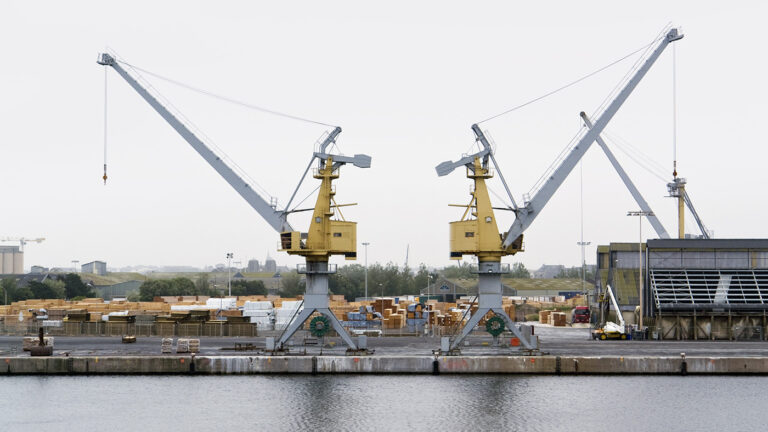Transcript
Hi. This is Carlos Centurion with RiverLogic.
Welcome to Real Talks, a series of chats with industry innovation leaders on topics such as supply chain, transformation, and innovation.
Today, we have with us here, Theresa Hamwick, VP of supply chain at Eco Material Technologies, he’s here with us to share some thoughts or some really cool innovations that they’ve been driving over at eco material. So, Theresa, would you share with us a little bit about your background and eco material technologies?
Sure. Well, eco material technologies is the combination of coral resource and green cement. We’re funded by Warwick Pincus, one equity partners, and quadrant.
We were formed in February of two thousand twenty two, and we are planning to more than double our growth by twenty thirty. So we’re on a very rapid rise.
My background, I came to what was moral resources at the time about four years ago with the idea that our business was changing in a very dynamic way. We were losing a lot of sources of product and had ideas around how to maximize the existing sources that we had.
So I came to borrow at the time with the goal with the mandate to put in executive sales and operations planning with a backbone of a network optimization tool. Like RiverLogic, but the tool hadn’t been chosen yet. I’ve been doing bulk materials, logistics, and supply chain for about twenty years. With other public companies and private companies, and I have a background in public accounting and finance. So I’ve been doing transportation supply chain and bulk materials for over twenty years now.
Wonderful.
And I know that we have been working with you and your borrowing capacity for quite some time and that you have been driving a lot of innovation even starting with those days.
Can you share a bit of how you got started and why you were seeking to get going around network optimization.
Sure. Well, our industry was in a a very dynamic downturn where our materials were going from a a peak volume in the United States of twenty nine million tonnes in 2006 down to fifteen million last year. So what we had to do was come up with a way to plan how we to get Flyesh and other cementitious products to our markets because we were losing local sources And what we decided to do was implement sales and operations planning and use a backbone, a a network optimization tool as a backbone to support that integrated business planning or sales and operations planning.
And what were the initial sort of kind of key three, four, five use cases that you tackled with that?
The first thing we did was try to optimize our fly ash network for the next twelve months.
The second, which we rolled out relatively effectively.
We went from taking our data and creating a digital twin, which is basically a a mirror of our financial projections. So that was sort of step one. Then we rolled out sales and operations planning. And then we were handed a pretty significant blow to our business where we lost one of our major sources. And so we needed to quickly evaluate whether or not we could keep a market that was difficult to supply.
So we evaluated using the RiverLogic tools, what the value of that market was to us. And instead of following what the business’s gut said, which was to exit the market, we actually proved using the tool that the market was valuable to us and that we needed to keep it. So it was counterintuitive even with all of the hundreds of years of experience that our executives on our team have. That’s wonderful.
And nothing just for context for the audience digital planning twin is essentially a replica of your business — Right. — in digital form and you use to test different hypotheses and ask questions of it and then come back and uses know, algorithms like optimization to recommend this might be the best way to do this, that’s subject to your objectives. Right.
I know that you are have a very interesting road map. Can you share with us where you’re going with this and what other use cases you’ve been adding or plan to add? Sure. So after the merger of beryl resources in green cement, we decided to add all of our product lines into the optimization tool and the sales and operations planning process.
When we first started out, we had the business that represented about eighty percent or more of our revenue. Since we implemented, we’ve added two more of the business units, and now this month we’re adding the final one. So we’re increasing this scope to include the entire business. And then we’re also expanding the scope.
We we just plan the business for twenty four months now. As part of the SNOP process. Now what we’re going to do is we’re going to implement a five year plan. So instead of just looking at what’s going to happen in the next two years, we’re looking further ahead with different planning buckets so that we can better evaluate some of our capital projects.
We can rank our capital projects, and we can financialize our five your plan with a link to our existing sales and operations planning process.
So this means you’re going to bring in your financial constraints and objectives very explicitly into into your five year plan? That’s right. Yeah. So that’s the next that’s the next project we’re working on.
We have two more projects that we’re adding. One is to at at currently, we only optimize from our production to our distribution centers or equivalent. Now what we’re adding is to expand our optimization from our plants to our DCs to our outbound customers, which will be a bit complicated. But we believe that there’s value there that’s worth evaluating.
To try to understand what could we do differently to better serve the market and wease out more value for our shareholders. So regarding the digital planning twin, I know that your business is is very complicated.
Can you share some of the challenges and how you overcame them in being able to represent your business in a digital model? So stakeholders in the business, when you ask them about the business, they’ll explain to you how complicated it is. So Project by project assumptions can change, and it’s very difficult to model. So we needed to overcome some resistance from our stakeholders and executives that we could model the business as the digital twin.
And we’ve did that when we were rolling out the project. We prove that we could get within ninety five percent of contribution margin based on historicals, that’s part of the process. And it’s very useful. For creating credibility in the tool in the process.
But since then, we’ve actually had our finance team looking at how we are at predicting the next month based on the last month. And so there’s been some really promising feedback around how accurate we be.
So we’ve we’ve faced challenges ourselves also when implementing the digital planning twin.
In aligning, what is reality to what is actually represented in the software, and that’s got to do with being able to represent with enough fidelity, what’s in the business while making the trade off of keeping the simplicity so people can ask questions and get valid, fast, recommendations.
There is a number of techniques that we’ve used to solve the problem, including the approach that we use to validate in the model to defining how much detail we need to put in there and then how that connects over to financial outcomes where we’ve done some pretty massive innovations as a business.
And so we totally relate to you having challenges on that, but we’re not surprised that you were able to overcome them even even a even in a complicated business, such as yours. And that all has probably require you to change the way your business plans and make decisions.
Can you say something about how you’ve driven that transformation?
Well, we started by implementing sales and operations planning. It’s a five step process that we execute every month.
We meet every month with our executives to gather data, scrub the data, we’re also starting to incorporate major projects as early as possible to test those to understand if what’s being rep, what’s being proposed to our stakeholders is executable. So you’d hate to build a plant and find out that you can’t build a road out of the that to serve the customers. So those are the kinds of analysis that we’re trying to incorporate into that process.
So making sure that people across different functions are collaborating ahead of making the decision so that you can see all the potential impacts that the decision might have or things that might impact the value of a given decision. Yep. That’s right. And our finance team is taking us stronger interest in the way we use the tool as well. So, like most businesses, we’re going to budget. And so, we’re working with finance to understand how we can incorporate this planning that we do every single month in the optimization tool, how we can make that as kind of the first step on the budgeting process to make sure that we’re not we don’t have two or three different sets of plans.
And how would that the output of this process improve the financial planning process? Well, the way that it would improve the financial planning process is you’re all using the same assumptions.
So if you have an expectation of what next month’s profitability will be to a contribution margin level or, you know, some kind of operating ratio, you can test that every month to the actuals. You only really budget once a year if you’re lucky, maybe multiple versions of the budget. But since we’re planning every month, it gives a line of sight of what what our results will be. Also, we we don’t really plan we don’t execute to the budget. We execute to the plan. So if there’s an opportunity where we can drive value out of the network because of current events, let’s say, or a customer need.
We can quickly respond, add the change in the plan to optimization, and financialize what that effect is. So if we make a change in our model, if we increase sales to this customer, If we’re in a shorter situation, there will be cascading effects to other customers. And so instead of just looking at one customer in a vacuum, we can look at the whole system, and we can do it in certainly less than a day. Then you translate all that into how that impacts your P and L, which is what the financial team wants see and how they potentially that’s gonna impact the result?
That’s right. The the finance team might ask us if we have an unplanned footage or some other event, they might ask us to model that so they can understand how they need to communicate to our stakeholders, how it can affect the cash flows, what other business effects there might be. And if we have bad news, we try to come up with way to counter it with good news. So we’re always looking for opportunities that we could chase or pursue in order to improve our margins.
So you can see things ahead of time because you’ve got your operational and financial picture combined, and sometimes it’s about capturing opportunities in the plan. Sometimes, you can see things that will affect you negatively and look for things on the margin where there is improvement and mitigation improvement. That’s right. That’s right. But one example is, you know, we we can try to optimize margins from the lowest margin customer to bring them up to the middle.
So if we have a very low margin there’s reasons for that.
What can we do to bring them up to the middle and just be average or perhaps better?
The other thing we use at Carlos is we might have a customer that’s very hard to supply. They’re very far away. They have very strict requirements, we’ll model that in optimization to see if we can have multiple ways to source it. So, instead of just using one source, we might open up the model to say, could we use two or three sources? How can we get our reliability as a supplier up here so that we can drive value in the business.
Got it. And so there’s a lot of different ways that you’re using that digital planning in in SNOP and operations financials, customer decisions, now you’re implementing more long term, what can you say about the benefits that you’ve been able to identify as a result of this so far?
One of the ones that leaps about is once the business gets used to using the tool, and it’s a it’s a very robust tool compared to tools that I’ve used in the past. So when you wanna financialize the model and understand the financial impacts, instead of having to create spread sheets outside of the model, the the model and the tool is powerful enough to tell you this is the impact. This is the impact on revenue. This is the impact on sales volumes. This is the impact for all of your KPIs right down to contribution margin for us.
So that’s very helpful because if you run a model and you have to do ten more hours of work to understand what the model says or even believe what’s in there, it can be daunting. But we’re so used to using it, we’ll run a sensitivity for a change in production or a change in price or a change in pattern, and we can see really quickly. What that discrete incremental change is. So that’s been very powerful for us.
The other thing that we’re starting to use it for is when we’re doing a big project, we can say, you know, give us the assumptions, and we can financialize what we believe the benefit of that project is for the next two years, and then jump from there. In the past, using other tools, it was very difficult to financialize those kinds of things. We can financialize it over time. We all of the models are sitting in one spot, so I can take model one and compare it to the model today.
It’s just very easy to use from from an interface or as an executive because I don’t run the model.
I can go in on my own anytime day or night and have access to what I’d like to look at. In terms of what’s happening in the business.
Wonderful. So you get a better translation of operation to financials, so you can you can see and make decision based on economic value.
I understand you can do things easier, faster, and that this is is also giving you the ability to quantify things that you couldn’t before around the big projects. Right.
And what would you say to people that are just kind of starting on their journey? What would be your advice and how they can get going? Well, when we started out, we certainly weren’t thinking that we were going to implement RiverLogic. We had another leading software provider that we were just going with them. But as good business people and procurement professionals, we decided to run an RFP and we also went to Gartner, and so we scanned the service area to see what’s out there, what should we use.
We had four companies coming in pitch. So we took our time. We were very thorough and scrubbing which software we wanted to select, and at the end of the day, it came down to value and customer references.
So RiverLogic had the best customer references for our line of business. You know, we’re not CPG, we’re not consumer products, we’re a bulk materials business. It’s a little bit different than other businesses.
And they had a resounding recommendation from their customers. So I would encourage everyone to run an RFP, talk to customers that are using it in a field that they’re using it in. Today, and possibly get a demo from a customer or ask for the software producer to produce a demo of your own business, a small piece of your own business, so that you can see if it’ll work, if it feels comfortable with your team.
Wonderful.
So today we’ve heard your vision for where you started. You implemented SNOP using network optimization as a backbone, you’ve connected that to financial outcomes so that you can drive actions that relate to in profit and margin, being able to identify issues, react sooner.
You’ve got a wonderful road map. You’ve had to deal with business transformation along the way to make sure all the functions are included.
We’ve seen that that’s generated a very good return on investment, or excited about the road map that you’re heading down.
And so I wanna thank you for sharing all these insights with with us today.
And thank the audience for joining us today. Yeah. Thank you.



